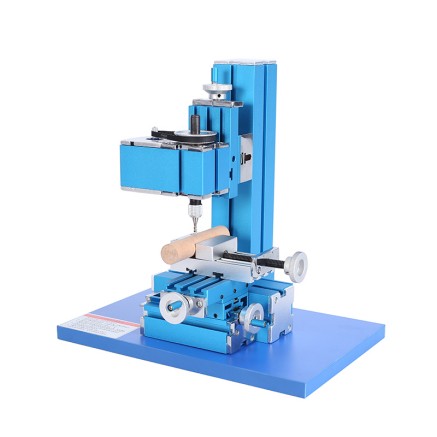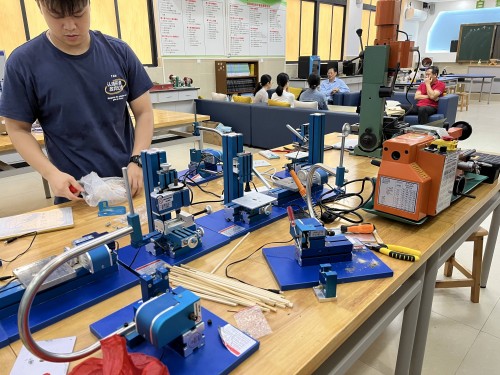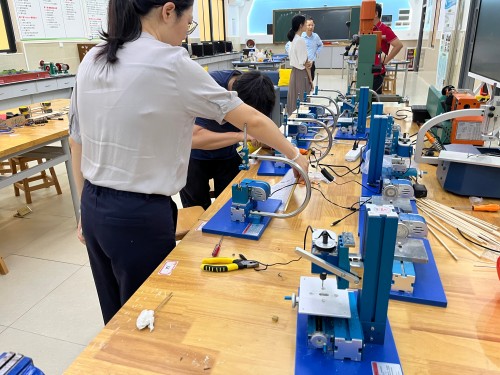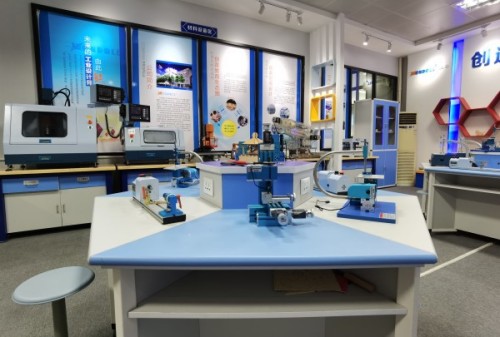Blog
Xendoll has 22 years of experience in the production of small machine tools. We will help you choose the suitable machine and share our experience in CNC machining with you.
 Nov 07, 2024
Nov 07, 2024
 Xendoll
Xendoll
 919
919
Universal metal milling machines (also known as small universal milling machines) are indispensable tools in precision machining and manufacturing, particularly for small parts and prototype production. Due to their compact structure and multifunctionality, these machines are widely used in small-scale production, workshops, educational institutions, and hobbyist environments. Universal metal milling machines not only improve machining efficiency but also help students and beginners master precision machining skills. In this article, we will explore the advantages and limitations of universal metal milling machines from an educational perspective, discuss how to improve their precision, and answer some common questions related to their use.

A universal metal milling machine (often referred to as a small universal milling machine) is a versatile tool capable of performing various tasks such as milling, drilling, sanding, and finishing metal parts. These machines are called "universal" because they allow adjustments to the spindle and worktable angles, enabling complex machining operations. This flexibility makes them ideal for both simple and intricate tasks, such as slotting, shaping, and surface finishing.
Compared to traditional industrial milling machines, universal metal milling machines are smaller, more affordable, and perfect for educational institutions and small workshops. These machines typically feature adjustable worktables that move along multiple axes (X, Y, Z) and a rotating spindle, making them suitable for a wide range of machining tasks.

Compact and Space-Efficient
One of the main advantages of universal metal milling machines is their compact size. They are designed to fit in small spaces, making them ideal for home workshops, small factories, and educational settings with limited floor space. Despite their small footprint, they can perform a variety of tasks, making them a valuable investment for schools and technical training centers.
Cost-Effective and Versatile
Universal metal milling machines are typically more affordable than larger industrial machines, making them an attractive option for educational institutions and small businesses. Their versatility allows them to handle a wide range of tasks, including milling, drilling, sanding, and shaping, reducing the need for multiple machines. Students can gain hands-on experience with various machining skills on a single machine, improving their practical abilities.
High Precision and Ease of Use
Although compact, universal metal milling machines offer high precision, typically within tolerances of 0.01 mm, making them ideal for teaching precision machining. The ability to adjust the spindle and worktable angles also allows for more complex operations, which is crucial in educational settings. Additionally, these machines feature intuitive interfaces that make them easy for beginners and students to operate.
Ideal for Teaching and Skill Development
Universal metal milling machines are designed for ease of use, making them perfect for teaching purposes. Many schools and vocational training centers use these machines to help students understand and practice basic machining techniques. Students can learn not only theoretical knowledge but also hands-on skills, which are essential for their development as skilled machinists.
Limited Work Area
The primary limitation of universal metal milling machines is their small work area. While this is an advantage for small parts, it limits the size of the workpieces that can be machined. Most educational projects typically involve smaller components, so this is not a significant issue. However, for more advanced courses or student projects that require larger parts, bigger machines may be needed.
Reduced Cutting Power
Due to their compact size, universal metal milling machines generally have less cutting power than industrial-grade machines. They may struggle to handle harder materials, such as steel, and may experience slower machining speeds and faster tool wear when working with tough materials. While suitable for small-scale precision work, these machines are not ideal for high-torque or large-scale production tasks.
Lower Rigidity
While relatively sturdy, universal metal milling machines lack the rigidity of larger industrial machines. This can lead to vibrations during high-speed cutting or heavy-duty milling, which affects machining accuracy and surface finish. In educational environments, vibrations can cause errors, so students need to learn how to handle and mitigate these issues during operations.
Slower Speeds for High-Volume Production
Universal metal milling machines operate at slower speeds and feed rates compared to larger, more powerful machines, which can be a disadvantage for high-production tasks. However, in an educational setting, slower speeds allow students to better understand the machining process and make adjustments as needed.

Despite their limitations, there are several ways to improve the precision and overall performance of universal metal milling machines. Here are some tips for enhancing their accuracy:
Regular Calibration
Regular calibration is crucial to ensure that the machine operates within the desired tolerances. This includes aligning the worktable and spindle, and ensuring all moving parts are properly adjusted. Calibration will help reduce errors and maintain machining accuracy.
Use of High-Quality Cutting Tools
Using high-quality cutting tools can significantly improve machining accuracy. Sharp, durable tools are less likely to cause deflection, vibration, or excessive wear, which would negatively affect precision. Teaching students how to select the right tools for different materials is an essential part of the learning process.
Optimizing Cutting Parameters
Adjusting cutting speed, feed rate, and cutting depth based on the material being machined can greatly improve precision. Slower cutting speeds, for example, can help reduce vibration and tool deflection, ensuring better surface quality. In an educational setting, students can experiment with different parameters to understand their impact on machining quality.
Vibration Reduction Measures
Adding vibration-damping pads or using specialized anti-vibration tool holders can help minimize unwanted machine movements during operations. This ensures that the machine remains stable while cutting, improving the quality of the finished product. Teaching students how to reduce vibrations is an important aspect of improving machining accuracy.
Regular Maintenance
Routine maintenance is key to keeping a universal metal milling machine in optimal condition. Cleaning, lubricating moving parts, and inspecting for wear and tear will prevent malfunctions and inaccuracies. Replacing worn-out parts like bearings and belts can also improve performance. Maintenance training should be an essential part of any curriculum focused on machining skills.
Using Accurate Workholding Fixtures
Using precise and secure workholding fixtures ensures that the workpiece stays in place during machining, preventing any movement or shifts that could lead to errors. Accurate fixtures help ensure consistent and precise results. Teaching students how to select and use appropriate fixtures is crucial to achieving high-quality machining.

Universal metal milling machines are used in a variety of tasks in education, including:
Surface Finishing: The sanding capability of these machines allows students to practice smoothing rough metal surfaces, improving both appearance and functionality.
Milling: Students can use the machine for basic milling operations like flat milling, slotting, and cutting complex shapes.
Drilling and Tapping: Universal metal milling machines can be equipped with drills and taps, allowing students to practice drilling precise holes and threading metal parts.
Prototyping and Custom Parts: With their precision and versatility, universal metal milling machines are ideal for prototyping and producing small batches of custom parts, giving students hands-on experience with real-world applications.
Universal metal milling machines provide an affordable, versatile, and precise solution for small-scale machining and metalworking tasks, making them ideal for educational settings. While they have some limitations in cutting power and work area, with proper calibration, tool maintenance, and operational adjustments, these machines can achieve high precision and efficiency. For schools and training centers, these machines offer an excellent opportunity for students to gain practical machining skills, preparing them for careers in precision manufacturing. Through hands-on experience, students can significantly improve their technical abilities and understanding of machining processes.



 Show all our samples
Show all our samples
 Provide you with a free quote
Provide you with a free quote
 Answer all the questions you may have
Answer all the questions you may have
 Guided installation and other options
Guided installation and other options